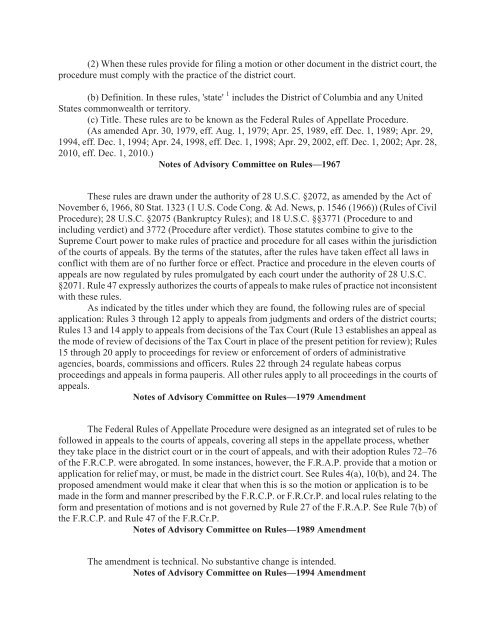Federal Rules of Appellate Procedure 2014-2015, 2014a
Federal Rules of Appellate Procedure 2014-2015, 2014a
Federal Rules of Appellate Procedure 2014-2015, 2014a
You also want an ePaper? Increase the reach of your titles
YUMPU automatically turns print PDFs into web optimized ePapers that Google loves.
(2) When these rules provide for filing a motion or other document in the district court, the<br />
procedure must comply with the practice <strong>of</strong> the district court.<br />
(b) Definition. In these rules, 'state' 1 includes the District <strong>of</strong> Columbia and any United<br />
States commonwealth or territory.<br />
(c) Title. These rules are to be known as the <strong>Federal</strong> <strong>Rules</strong> <strong>of</strong> <strong>Appellate</strong> <strong>Procedure</strong>.<br />
(As amended Apr. 30, 1979, eff. Aug. 1, 1979; Apr. 25, 1989, eff. Dec. 1, 1989; Apr. 29,<br />
1994, eff. Dec. 1, 1994; Apr. 24, 1998, eff. Dec. 1, 1998; Apr. 29, 2002, eff. Dec. 1, 2002; Apr. 28,<br />
2010, eff. Dec. 1, 2010.)<br />
Notes <strong>of</strong> Advisory Committee on <strong>Rules</strong>—1967<br />
These rules are drawn under the authority <strong>of</strong> 28 U.S.C. §2072, as amended by the Act <strong>of</strong><br />
November 6, 1966, 80 Stat. 1323 (1 U.S. Code Cong. & Ad. News, p. 1546 (1966)) (<strong>Rules</strong> <strong>of</strong> Civil<br />
<strong>Procedure</strong>); 28 U.S.C. §2075 (Bankruptcy <strong>Rules</strong>); and 18 U.S.C. §§3771 (<strong>Procedure</strong> to and<br />
including verdict) and 3772 (<strong>Procedure</strong> after verdict). Those statutes combine to give to the<br />
Supreme Court power to make rules <strong>of</strong> practice and procedure for all cases within the jurisdiction<br />
<strong>of</strong> the courts <strong>of</strong> appeals. By the terms <strong>of</strong> the statutes, after the rules have taken effect all laws in<br />
conflict with them are <strong>of</strong> no further force or effect. Practice and procedure in the eleven courts <strong>of</strong><br />
appeals are now regulated by rules promulgated by each court under the authority <strong>of</strong> 28 U.S.C.<br />
§2071. Rule 47 expressly authorizes the courts <strong>of</strong> appeals to make rules <strong>of</strong> practice not inconsistent<br />
with these rules.<br />
As indicated by the titles under which they are found, the following rules are <strong>of</strong> special<br />
application: <strong>Rules</strong> 3 through 12 apply to appeals from judgments and orders <strong>of</strong> the district courts;<br />
<strong>Rules</strong> 13 and 14 apply to appeals from decisions <strong>of</strong> the Tax Court (Rule 13 establishes an appeal as<br />
the mode <strong>of</strong> review <strong>of</strong> decisions <strong>of</strong> the Tax Court in place <strong>of</strong> the present petition for review); <strong>Rules</strong><br />
15 through 20 apply to proceedings for review or enforcement <strong>of</strong> orders <strong>of</strong> administrative<br />
agencies, boards, commissions and <strong>of</strong>ficers. <strong>Rules</strong> 22 through 24 regulate habeas corpus<br />
proceedings and appeals in forma pauperis. All other rules apply to all proceedings in the courts <strong>of</strong><br />
appeals.<br />
Notes <strong>of</strong> Advisory Committee on <strong>Rules</strong>—1979 Amendment<br />
The <strong>Federal</strong> <strong>Rules</strong> <strong>of</strong> <strong>Appellate</strong> <strong>Procedure</strong> were designed as an integrated set <strong>of</strong> rules to be<br />
followed in appeals to the courts <strong>of</strong> appeals, covering all steps in the appellate process, whether<br />
they take place in the district court or in the court <strong>of</strong> appeals, and with their adoption <strong>Rules</strong> 72–76<br />
<strong>of</strong> the F.R.C.P. were abrogated. In some instances, however, the F.R.A.P. provide that a motion or<br />
application for relief may, or must, be made in the district court. See <strong>Rules</strong> 4(a), 10(b), and 24. The<br />
proposed amendment would make it clear that when this is so the motion or application is to be<br />
made in the form and manner prescribed by the F.R.C.P. or F.R.Cr.P. and local rules relating to the<br />
form and presentation <strong>of</strong> motions and is not governed by Rule 27 <strong>of</strong> the F.R.A.P. See Rule 7(b) <strong>of</strong><br />
the F.R.C.P. and Rule 47 <strong>of</strong> the F.R.Cr.P.<br />
Notes <strong>of</strong> Advisory Committee on <strong>Rules</strong>—1989 Amendment<br />
The amendment is technical. No substantive change is intended.<br />
Notes <strong>of</strong> Advisory Committee on <strong>Rules</strong>—1994 Amendment


















